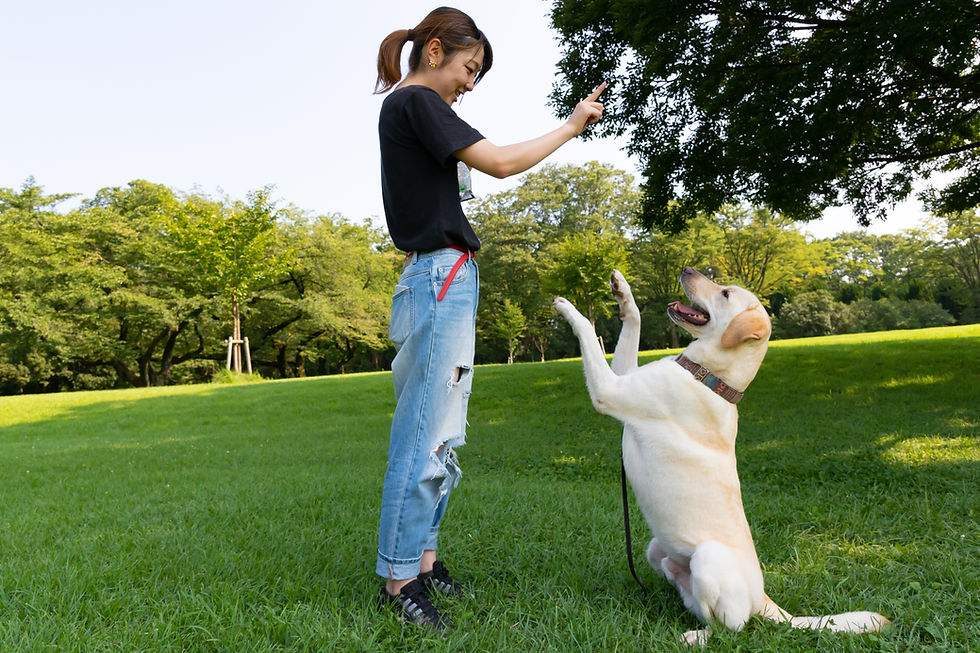Safe Car Travel
- Awesome Dog Academy

- Jan 8, 2020
- 4 min read
Updated: May 17, 2021

So, if we want to keep our pet safe and secure while riding in a car, what options do we have available to us?
We believe that dogs inside vehicles should be restrained, for their own safety as well as that of other passengers. Unrestrained, an excited or scared dog can disrupt your driving, causing a serious accident. Even the best-behaved dogs can be violently thrown into the seat in front of them, or, worse, into or through the windshield in an accident. If dog and passengers survive impact, a terrified dog (possibly in shock) can escape through broken car windows and become a traffic hazard. While it’s true that one reason to crate or seat belt your dog in your car is to keep them as safe as possible in an accident, another is to keep you from being injured in a wreck. A free-flying dog body can become a deadly projectile, causing serious injury to you or other vehicle passengers if they hit you.
Crating is the recommended solution, as it provides your dog with a small, comfortable space, where they cannot fall off of seats or be injured by air bags. Crates can fit in the trunk or the back seat, both locations allow the crate to be strapped in place so it will not roll or slide around while the car is in motion. This further prevents your dog from disrupting your driving with excited paws, barking or even getting under your feet. By using a crate, you can ensure your pet is safe and secure during your drive.

If your car is too small to accommodate a portable kennel. A reasonable alternative is a restraint system that holds your dog securely in place. The use of restraints undeniably prevents canine injuries; who among us hasn’t, at some point in their driving career, had to slam on the brakes in traffic and had their dog flung against the seat, or dashboard in front of them? Restraints save canine lives. For safety reasons, all restraint devices should be used with a harness, not attached to a collar. There are two basic types of canine restraints: canine safety harness, and a canine car seat.
Please note: Awesome Dog Academy never recommends keeping your dog in the front seat of your car. Dogs should always be buckled up in the back seat of your vehicle. Just like small children, they risk severe injury or death from air bags in the front seats of most newer cars. Remember: Air bags can be engaged in even very slow-speed accidents, but deploy with lighting speed and potentially dog-crushing force.

Canine safety harnesses
Each consists of a body harness that attaches to the car seat belt. Important criteria to consider are: strength and durability of straps and hardware, comfort, and ease of use. The harness should be fitted to make sure it is comfortable to your dog, but not too loose or too tight. Here is where a bit of padding can come in handy! In an accident, a harness spreads the strain of the impact of the body across the chest instead of placing all of it on your dog’s throat (which would happen if the seat belt were hooked to their collar). Make sure to check the hardware of the harness you are considering purchasing, and ensure it is strong, not something flimsy and breakable like some plastics.
Canine Car Seats
The amount of selection for canine car seats has gone up greatly, and there are lots of considerations for you to take into account. Car seats are aimed for the small breeds, as there aren’t options for larger dogs. There are many styles for you to take into consideration, though again, we would like to remind you that even if your dog is in a car seat, they should not be in the front seats of your vehicle. Some dog car seats are more backpack style with straps that hold it up on the back of the seat and a more pouch like seating arrangement for your dog. Other car seats are crafted from molded plastic and sit on the seat itself, using the car seatbelt to hold it in place, much like a child’s car seat. These are great for giving your dog a chance to look through windows while being safe. Again, look for comfort, quality fittings and straps, along with a good secure anchor point which will keep your dog in place. If your car seat attaches to your dog with only one hook or strap, you will want to use a harness with it as well.
A quick note: We do not ever suggest a dog ride in the back of a pick-up truck, restrained or not. There are seat belt laws in most states which address restraint for dogs in the back of open pick-up trucks. (And even when dogs are safely restrained in the back of a truck, the potential for the dog to be severely injured in an accident is great. The risk of damage to eyes from flying debris, the discomfort from exposure to the elements, and the encouragement of aggressive dog behavior, and the real possibility of jumping or falling from trucks are other good reasons not to allow your dog to ride in the back of trucks.)



Comments